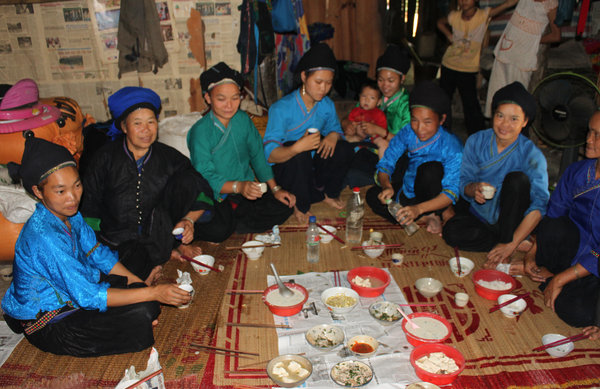Tailor Made Holidays with our travel experts
We'll do our best to call you within 48h

Vietnam is a multi-ethnic country with over fifty distinct groups (54 are recognized by the Vietnamese government), each with its own language, lifestyle, and cultural heritage. Many of the local ethnic groups are known collectively in the West as Montagnard or Degar. The largest ethnic groups are: Kinh (Viet) 86.2%, Tay 1.9%, Tai Ethnic 1.7%, Mường 1.5%, Khmer Krom (Khơ Me Crộm) 1.4%, Hoa 1.1%, Nùng 1.1%, Hmong 1%, others 4.1% (1999 census). The Vietnamese term for ethnic group is literally "minority people".
The Nùng (pronounced as noong [nuːŋ]) are an ethnic minority in Vietnam whose language belongs to the Central Tai branch of the Tai-Kadai language family. The Nùng sometimes call themselves as Tho (Vietnamese: Thổ, a shared name between the Tày and the Cuối, literally means Natives). In traditional times, they were sometimes referred by the Vietnamese as Thai. The term Thai Nung is also used to distinguish them with the Chinese Nùng who were the majority ethnic group in the Nung Autonomous Territory of Hai Ninh (1947-1954). The Nùng's ethnic name is often mingled with the Tày as Tày-Nùng.
The Nùng reside primarily in the northern Vietnamese provinces of Cao Bằng, Lạng Sơn, with considerable numbers in Bắc Giang, Bắc Kạn, Thái Nguyên, Quảng Ninh, Lào Cai, Hà Giang, Tuyên Quang, Yên Bái and they can also be found in Lâm Đồng, Đắc Lắc (migrated after the Sino-Vietnamese War in 1979) and Hồ Chí Minh City.
According to the Vietnam census, the population of the Nùng numbered about 856,412 by 1999 and 968,800 by 2009. It's estimated to be more than 1,000,000 in 2014 (based on the 2009 census and 5 years of population growth). In Vietnam, the Nùng are the third largest Tai-speaking group, preceded by the Tày and the Thái (Black Tai, White Tai and Red Tai groups), and sixth overall among national minority groups.
They are closely related to the Tày and the Zhuang. In China, the Nùng, together with the Tày, are classified as Zhuang people. The Nùng are divided into several sub-groups such as: Nùng Xuồng, Nùng Giang, Nùng An, Nùng Phàn Sình, Nùng Lòi, Nùng Cháo, Nùng Quý Rỉn, Nùng Dín, Nùng Inh, Nùng Tùng Slìn, Nùng Hàn Xích, Nùng Sẻng, Nùng Gửi, Nùng Vảng, Nùng Giang Viện, Nùng Si Kết, Nùng Vên (Én) etc.
Many of the Nùng's sub-group names correspond to the geographic regions of the Nùng homeland. Hoàng Nam (2008:11) lists the following Nùng subgroups.
• Nùng Inh: migrated from Long Ying
• Nùng Phàn Slình: migrated from Wan Cheng
◦ Nùng Phàn Slình thua lài
◦ Nùng Phàn Slình cúm cọt
• Nùng An: migrated from An Jie
• Nùng Dín
• Nùng Lòi: migrated from Xia Lei
• Nùng Tùng Slìn: migrated from Cong Shan
• Nùng Quý Rỉn: migrated from Gui Shun
• Nùng Cháo: migrated from Long Zhou
Clothing mainly in an indigo color, the Nung women wear five-panel robes with buttons under the right armpit. Men wear shirts upright collar leaving open at breast and belly but having a row of cloth bottons and four pockets without cover.
They live in wide stilt house with the outer compartment reserved for men and ancestor worship and the inner one reserved for women. Nung people do not celebrate death anniversaries, which makes birthday (celebration of life) for those beyond 50 years old and worship for the dead on July 15th, of lunar calender.
Wedding ceremonies still preserve many ancient customs and the brother of the groom’s mother plays a very important role in representing the groom’s family in mariage proposal and organising all ceremonies related to the wedding. The Nung flokloric culture is very famous with the “Sli”, a love dialogue song of the youth.
54 ETHNIC GROUPS IN VIETNAM
At present there are 54 different ethnic groups inhabiting Vietnam, in which Kinh (Viet) people make up nearly 86% of the whole population, and 53 other ethnic groups represent over 14%.
The Vietnamese nation was formed through a process of two major ancient cultures, the Chinese and the Indian. Thus a peculiar trait of Vietnam's culture was formed. As far as anthropology is concerned the Vietnamese people have their origin in the Mongolid race, believed to be one of the major or races of the world and often found in northern and eastern Asia.
* 54 different ethnic groups inhabiting Vietnam can divide eight different groups by the Vietnamese language:
- The Viet - Muong Group includes 4 ethnic groups: Chut, Kinh, Muong, Tho.
- The Tay - Thai Group includes 8 ethnic groups: Bo Y, Giay, Lao, Lu, Nung, San Chay, Tay, Thai.
- The Mon - Khmer Group includes 21 ethnic groups: Ba Na, Brau, Bru-Van Kieu, Cho Ro, Co, Co Ho, Co Tu, Gie Trieng, Hre, Khang, Khmer, Kho Mu, Ma, Mang, M'nong, O Du, Ro Mam, Ta Oi, Xinh Mun, Xo Dang, Xtieng.
- The Mong - Dao Group includes 3 groups: Dao, Mong, Pa Then.
- The Kadai Group includes 4 ethnic groups: Co Lao, La Chi, La Ha, Pu Peo.
- The Nam Dao Group includes 5 ethnic groups: Cham, Chu Ru, Ede, Gia Rai, Raglai.
- The Han Group includes 3 ethnic groups: Hoa, Ngai, San Diu.
- The Tang Group includes 6 ethnic groups: Cong, Ha Nhi, La Hu, Lo Lo, Phu La, Si La.
In the core of the history of national development, all these groups of people have been closely attached to one another in sharing the same tasks of fighting against foreign invaders, defending the country's territory, gaining the right to live and the right to national independence and self-determination. Each group of ethnic people have developed their own language and identity, thus making the Vietnamese culture, long known for its variety, a well blended combination of different culture.